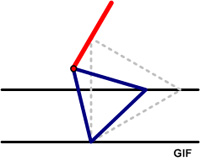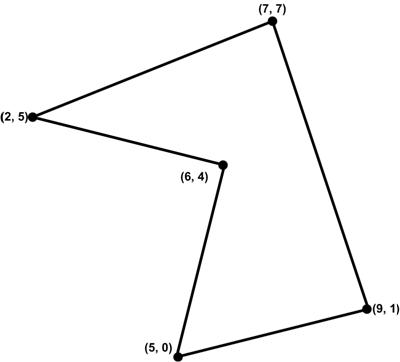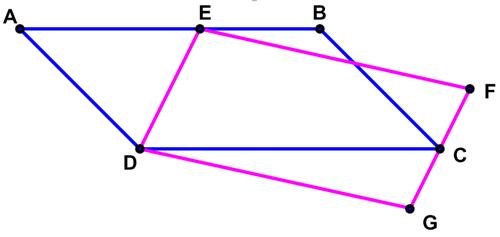 Here is another simple problem from Futility Closet.
Here is another simple problem from Futility Closet.
“Draw an arbitrary triangle [ABC] and build an equilateral triangle on each of its sides, as shown. Now show that [straight lines] AP = BQ = CR.”

 Here is another simple problem from Futility Closet.
Here is another simple problem from Futility Closet.
“Draw an arbitrary triangle [ABC] and build an equilateral triangle on each of its sides, as shown. Now show that [straight lines] AP = BQ = CR.”
 This statement showed up recently at Futility Closet and I found it to be another one of those magical results that seemed so surprising. I don’t recall ever seeing this before.
This statement showed up recently at Futility Closet and I found it to be another one of those magical results that seemed so surprising. I don’t recall ever seeing this before.
“The radius of a circle inscribed in a 3-4-5 triangle is 1.
(In fact, the inradius of any Pythagorean triangle is an integer.)”
(A Pythagorean triangle is a right triangle whose sides form a Pythagorean triple.) Futility Closet left these remarkable statements unproven, so naturally I felt I had to provide a proof.
 The following interesting behavior was found at the Futility Closet website:
The following interesting behavior was found at the Futility Closet website:
“A pleasing fact from David Wells’ Archimedes Mathematics Education Newsletter: Draw two parallel lines. Fix a point A on one line and move a second point B along the other line. If an equilateral triangle is constructed with these two points as two of its vertices, then as the second point moves, the third vertex C of the triangle will trace out a straight line. Thanks to reader Matthew Scroggs for the tip and the GIF.”
This is rather amazing and cries out for a proof. It also raises the question of how anyone noticed this behavior in the first place. I proved the result with calculus, but I wonder if there is a slicker way that makes it more obvious. See the Straight and Narrow Problem.
(Update 3/25/2019) Continue reading
 Futility Closet presented a nifty method of solving the “counterfeit coin in 12 coins” problem in a way I had not seen before by mapping the problem into numbers in base 3. It wasn’t immediately clear to me how their solution worked, so I decided to write up my own explanation.
Futility Closet presented a nifty method of solving the “counterfeit coin in 12 coins” problem in a way I had not seen before by mapping the problem into numbers in base 3. It wasn’t immediately clear to me how their solution worked, so I decided to write up my own explanation.
Futility Closet: “You have 12 coins that appear identical. Eleven have the same weight, but one is either heavier or lighter than the others. How can you identify it, and determine whether it’s heavy or light, in just three weighings in a balance scale? This is a classic puzzle, but in 1992 Washington State University mathematician Calvin T. Long found a solution ‘that appears little short of magic.’ ”
 Futility Closet offers another interesting puzzle:
Futility Closet offers another interesting puzzle:
“A billiard ball is resting on a table that measures 10 feet by 5 feet. A player hits it with no ‘English’ and it strikes four different cushions and returns to its starting point. University of Alberta mathematician Murray Klamkin asks: How far did it travel?”
After solving the problem myself, I verified that Futility Closet provides an answer, but without real justification. So I thought I would write up my solution.
See Pool Party for a solution.
 This problem from Futility Closet proved quite challenging.
This problem from Futility Closet proved quite challenging.
“University of Illinois mathematician John Wetzel called this one of his favorite problems in geometry. Call a plane arc special if it has length 1 and lies on one side of the line through its end points. Prove that any special arc can be contained in an isosceles right triangle of hypotenuse 1.”
My attempts were futile (maybe that is where the title of the website comes from). Maybe this qualifies for another Coffin Problem. But I did have one little comment about the Futility Closet solution. See Containing an Arc.
 From Futility Closet we have another intriguing problem with what turns out to be a simple and elegant solution.
From Futility Closet we have another intriguing problem with what turns out to be a simple and elegant solution.
“If squares are drawn on the sides of a triangle and external to it, then the areas of the triangles formed between the squares each equal the area of the triangle itself.”
I originally assumed that the center triangle was a right triangle as suggested by the picture. But then I realized there was a solution that did not depend on that. See Four of a Kind.
 This is another problem from Futility Closet, though Futility Closet provides a “solution” of sorts. They provide a set of steps without explaining where they came from. So I thought I would fill in the gap. The problem is to find the area of an irregular polygon, none of whose sides cross one another, if we are given the coordinates of the vertices of the polygon.
This is another problem from Futility Closet, though Futility Closet provides a “solution” of sorts. They provide a set of steps without explaining where they came from. So I thought I would fill in the gap. The problem is to find the area of an irregular polygon, none of whose sides cross one another, if we are given the coordinates of the vertices of the polygon.
See Polygon Areas Problem for a solution.
 Yet another Futility Closet puzzle.
Yet another Futility Closet puzzle.
“Point E lies on segment AB, and point C lies on segment FG. The area of parallelogram ABCD is 20 square units. What’s the area of parallelogram EFGD?”
I had an alternative solution that I thought was a bit simpler and clearer. See the Parallelogram Puzzle for solutions.
 This is another Futility Closet puzzle.
This is another Futility Closet puzzle.
“Four straight roads cross a plain. No two are parallel, and no three meet in a point. On each road is a traveler who moves at some constant speed. If Blue and Red meet each other at their crossroad, and each of them meets Yellow and Green at their respective crossroads, will Yellow and Green necessarily meet at their own crossroad?”
I was not able to understand the solution given at first, so I tried to solve the problem on my own. Once I did, I was able to see what the Futility Closet solution was getting at. Certainly diagrams were needed to make sense of it all, and that is what I provided. See the Four Travelers Problem.